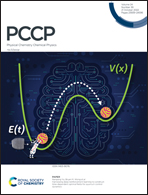Adsorption of acrolein and its hydrogenation products on Cu(111)
Abstract
The adsorption of acrolein and its hydrogenation products propanal, 1-propanol, and 2-propenol on Cu(111) was studied by reflection absorption infrared spectroscopy (RAIRS) and temperature-programmed desorption (TPD). The experimental RAIR spectra were obtained by adsorbing multilayers of each molecule at 85 K and then annealing the surface up to 200 K to desorb the multilayer and produce the most stable monolayer structure on the surface. Each of the four molecules adsorbs weakly to the surface and desorbs at temperatures below 225 K. Compared to acrolein and propanal, the two alcohols, 2-propenol and 1-propanol, have notably higher desorption temperatures and broadened and redshifted O-H stretches that reveal strong hydrogen bonding in the multilayers. Upon annealing to 160 K, the OH stretches of both 2-propenol and 1-propanol disappear, indicating the hydrogen bonding in the multilayers is not present in the monolayers. For 2-propenol, the hydrogen bonding in the multilayer correlates with the observation of the C![[double bond, length as m-dash]](https://www.rsc.org/images/entities/char_e001.gif) C stretch at 1647 cm−1, which is invisible for the monolayer. This suggests that the C
C stretch at 1647 cm−1, which is invisible for the monolayer. This suggests that the C![[double bond, length as m-dash]](https://www.rsc.org/images/entities/char_e001.gif) C bond is parallel to the surface for monolayer coverages of 2-propenol. Similarly, for propanal, the C
C bond is parallel to the surface for monolayer coverages of 2-propenol. Similarly, for propanal, the C![[double bond, length as m-dash]](https://www.rsc.org/images/entities/char_e001.gif) O stretch peak at 1735 cm−1 compared to those at 1671 and 1695 cm−1 is very weak at low coverages but becomes the most prominent peak for the multilayer, indicating a change in molecular orientation. For acrolein, the out-of-plane bending modes are more intense than the C
O stretch peak at 1735 cm−1 compared to those at 1671 and 1695 cm−1 is very weak at low coverages but becomes the most prominent peak for the multilayer, indicating a change in molecular orientation. For acrolein, the out-of-plane bending modes are more intense than the C![[double bond, length as m-dash]](https://www.rsc.org/images/entities/char_e001.gif) O stretch at submonolayer coverages, indicating that the molecular plane is mainly parallel to the surface. In contrast, the opposite intensity trend was observed for multilayer acrolein, suggesting that the C
O stretch at submonolayer coverages, indicating that the molecular plane is mainly parallel to the surface. In contrast, the opposite intensity trend was observed for multilayer acrolein, suggesting that the C![[double bond, length as m-dash]](https://www.rsc.org/images/entities/char_e001.gif) O bonds are tilted away from the surface.
O bonds are tilted away from the surface.



 Please wait while we load your content...
Please wait while we load your content...